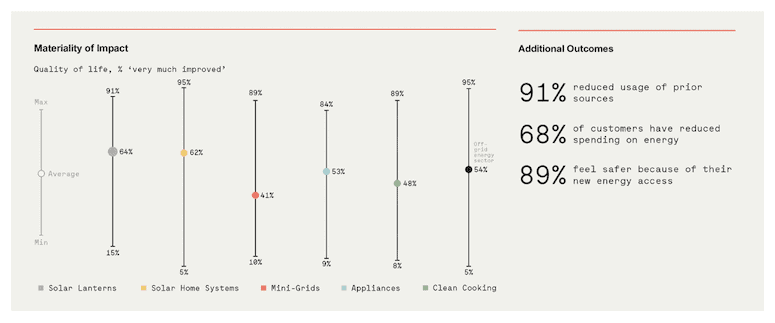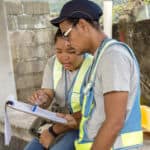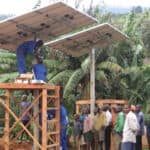Empowering the Underserved: A New Report Highlights the Impact of Off-Grid Energy Solutions — And Some Emerging Challenges
As it currently stands, the world is not on track to achieve universal electricity access by 2030: 660-674 million people living in the most rural and impoverished communities are expected to remain unelectrified. Off-grid energy products can support these hardest-to-reach communities, offering not just light and electricity, but pathways to financial empowerment and resilience. Ensuring that off-grid energy businesses and organizations have the right support to successfully scale to reach these populations will be key to closing the electrification gap.
At 60 Decibels, we have found that the off-grid energy sector is making a material difference for hundreds of millions of people around the globe. And based on our interviews with 79,000 energy customers in over 30 different countries in the last three years, we’ve learned that the off-grid sector — with some adjustments — could reach hundreds of millions more when scaled further.
The Data is Clear: Solar Power is Improving Lives
For more than half of all the customers we interviewed, the quality of their and their families’ lives improved significantly as a result of their newfound energy access. The data shows that solar lanterns and solar home systems, in particular, play a key role in this improvement in well-being. “Our life is better now. Our health is no longer exposed to paraffin smoke,” one solar lantern user noted.
More specifically, 64% of customers told us that a simple solar lantern brought a significant change to their quality of life, and 62% said a new solar home system had a major impact on their lives. Three-quarters of customers said this was the first time they’ve had access to a product of this category, and 53% of those reached are living in a rural area. The chart below highlights some additional impacts of these customers’ growing energy access.

Off-Grid Energy’s Impact on Poverty Alleviation
Rural areas often contribute minimally to climate change, yet they disproportionately bear the consequences. Off-grid energy has the power to help build these populations’ resilience to climate change, while reducing carbon emissions.
More than half of the total surveyed customers reside in rural areas, and these individuals have higher levels of satisfaction and experienced impact compared to the sector’s average. Rural customers are three times more likely to be living below the poverty line when compared with their urban counterparts.
Rural customers are also more likely to experience significant improvements from gaining energy access than their urban peers, including enhanced safety, improved health outcomes, increased knowledge and more convenience. Solar lanterns are reaching the largest proportion of these rural customers, with a significant 83% rural reach.
When it comes to reaching low-income populations, distributors in the off-grid sector are underserving this group, on average, in their respective geographies. While this surpasses comparable sectors in which we’ve completed large-scale impact measurement studies, such as agriculture and financial inclusion, there remains plenty of room for improvement. Given that most of the people who still lack energy access live in rural, low-income areas, targeting these geographies presents a compelling opportunity for companies to expand into new areas and markets while having a substantial positive impact.
Financing Challenges and Consumer Protection in the Off-Grid Energy Sector
More than other demographics, rural communities face significant financial volatility. Since those living in rural areas often rely on agriculture for their income, their means of income often fluctuates during lean periods, like before a harvest, or when other financial commitments arise, like school fees. Some companies have adjusted for this and introduced financing options to help customers afford off-grid products year-round. In our study, we found that three-quarters of the customers surveyed utilize some form of financing to secure energy access.
While PAYGo models have extended energy access to individuals who would otherwise be unable to afford it, they also carry risks of over-indebtedness. Notably, 5% of those surveyed found payments for their energy device to be a significant financial burden, and 30% said they had fallen behind on payments at some point. Why do customers fall behind on payments? Loss of income, increased living costs and unforeseen emergencies are the most common responses.
In response to these challenges, efforts to enhance consumer protection have come into the spotlight. To support these efforts, in collaboration with the Global Off-Grid Lighting Association (GOGLA), we designed and introduced the Consumer Protection Score. This benchmark explores customers’ awareness of key contract terms, their ability to pay, and ease of use. In other words, it looks at key themes such as transparency, fair pricing and customer experience when off-grid energy customers are purchasing a new product or service. Our findings revealed that a third of customers experience some consumer protection-related challenges — establishing an important starting point from which to improve, and underscoring the urgent need for advancement in this area. An important note: We’re sharing averages here, but Consumer Protection Scores varied substantially by product category, company, etc.
A common customer experience: Difficulties using their energy product or service
Notably, a third of customers experience some sort of challenge using their energy product or service, on average — a substantial number. These challenges fit into four themes:
- Technical fault: when a product malfunctions.
- Mismatched expectations: when customers anticipate different outcomes.
- Misuse: when customers use products incorrectly, often due to a lack of awareness or training.
- External factors: when factors beyond anyone’s control, like theft or environmental issues, disrupt product usage.
When these challenges arise, customers and their families can’t unlock the many benefits of improved energy access. Overall, the off-grid energy sector performs well globally in terms of customer satisfaction, with a Net Promoter Score® (NPS) of 43 — for context, an NPS can range from -100 to 100, so a score of over 20 is considered fair, and a score of over 40 is considered good. However, the NPS for those with unresolved issues falls to 1 (compared to 56 among customers who face no issues), and 71% of the customers we surveyed who faced challenges have yet to see them resolved. In response to these numbers, a review and improvement of issue resolution policies and processes is a must for the sector. Additionally, improved design, accurate sales and marketing materials, training and installation for users, and great after-sales care are needed, to increase the impact of off-grid energy products on the people they serve.
Finally, it’s important to recognize that first-time customers are more likely to face challenges, emphasizing the need for targeted support during initial product usage. Organizations should focus on the experience of early adopters, especially in nascent markets: Their satisfaction and recommendations to peers and networks can significantly impact sales and growth.
Locally-owned and/or women-led enterprises are impact all-stars
When assessing the landscape of companies and organizations offering off-grid energy products, we unearthed some pretty compelling insights. Locally-owned organizations emerged as standout performers, with higher levels of social impact, broader female reach, greater representation of lower-income customers, and superior ratings in terms of ease of use and customer satisfaction. This suggests a deep understanding of the challenges faced by these populations.
Similarly, women-led organizations also showcased impressive results, demonstrating heightened impact and outreach among female populations, along with lower consumer over-indebtedness rates, and lower rates of the usage challenges discussed above.
However, amidst these promising findings lies a concerning reality: Both women-led and locally-owned entities are woefully underrepresented in the flow of capital within the off-grid energy sector. This is a missed opportunity to increase the impact of off-grid energy solutions.
These solutions offer a transformative pathway to uplift rural communities and combat energy poverty. They can play a pivotal role in enhancing livelihoods, expanding markets and driving sustainable development. We hope the findings from this report help to foster dialogue, drive innovation and channel resources towards initiatives that empower the underserved.
Download the full report: Why Off-Grid Energy Matters 2024.
Kat Harrison is Director of Impact at 60 Decibels.
Photo credit: Prashanth Vishwanathan (IWMI)



